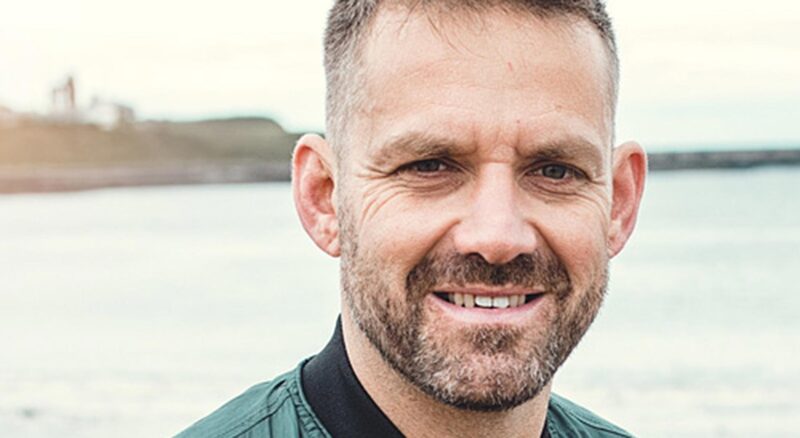You are viewing your 1 free article this month. Login to read more articles.
Forensic fiction
Is there a more popular genre in the crime fiction field (on the printed page or TV screen) than the forensic pathologist? An army of world-weary, alcoholic detectives perhaps had readers feeling in need of a change – and that change exploded in the shape of clue-sifting medical examiner protagonists usually to be found up to their elbows in bones and blood. Crimes were now to be solved in the lab as much as at a crime scene, with a minute examination of such gruesome artefacts as human skin now the key to tracking down a murderer.
The poster girl for the field is, of course, the phenomenally successful American Patricia Cornwell (who now travels with her own bodyguard after threats from 'unstable' readers), but she didn't inaugurate the forensic crime genre. In fact, one infallible way to annoy the late Ed McBain was to mention that one of the many innovations he brought to the crime novel in his 87th Precinct books – starting in 1956 with Cop Hater – was turned into cash-generating franchises by others: the role of forensics in police work.
Alongside McBain – who also wrote the screenplay for Hitchcock's film The Birds – another male author helped define the forensic fiction parameters. Veteran American novelist Robin Cook (not to be confused with the late mountain-hopping UK politician) specialises in impeccably detailed, plausible medical thrillers. Influentially, with Coma (1977) he introduced a young woman with medical training as the central character, instead of a jaundiced, middle-aged copper. It was to be a significant innovation, spawning many similar heroines, and similarly it is female authors who have taken the genre to new heights in the past two decades. Two American crime novelists in particular, Cornwell and Kathy Reichs, have taken their forensic anthropologist heroines on to a rarefied strata of success. As if evidence were needed of the breakthrough of forensic crime fiction into the mainstream, US TV's CSI: Crime Scene Investigation, which started in 2000 and shot its crime scenes in an unsparingly graphic fashion in a gaudily photographed Las Vegas, became the most popular TV show in the world. The scalpel and the examining table went high tech and forensics became a staple of TV and crime books for good.
The forensics supremo
There is absolutely no question as to who now rules the roost in forensic crime fiction. After her first novel Postmortem (1990), Patricia Cornwell bagged almost every important crime award and consolidated her success with a sequence of books featuring the tenacious (if vulnerable) Dr Kay Scarpetta, now the definitive fictional forensic pathologist. Cornwell's books were a canny marriage of traditional police procedure with something new: an investigation based on minutely detailed and gruesome posthumous evidence. Successive novels firmly fixed the author as a brand, and such books as Blow Fly (2003) made even the sanguinary excesses of the earlier books look restrained, with Scarpetta's independence making her deeply unpopular with her long-suffering bosses.
Cornwell's own baptism of fire came from her earlier experience as a crime journalist. As she put it: "My interest in pathology probably began when I heard about a Death Row inmate being beaten to death by fellow prisoners when I was on a night shift in 1980. I remember phoning up a nurse and asking about the victim's injuries. This question was met with some surprise, but basically I was taking the view of an archaeologist looking at a given set of circumstances. The morgue became a place of fascination for me."
Cornwell, however, acquired a new and distracting preoccupation: proving to a sceptical world that the English artist Walter Sickert was, in fact, Jack the Ripper. Few were persuaded, and in any case, it was felt that such side issues were postponing a return to vintage Scarpetta territory (the author is characteristically prickly when her views on Sickert are challenged). But the return to form came with Predator (2005), a book whose steely authority summoned memories of Cornwell in her prime, with Scarpetta anxious to succeed in her new job as Director of Forensic Science.
A key influence on Cornwell has been a series of books based on real-life cases. Two of the most significant figures in the field are the writers who are collectively 'Jefferson Bass', Dr Bill Bass and Jon Jefferson. Bass is a forensic anthropologist, whose books are based on his own experiences. A meeting with Jon Jefferson was significant: Jefferson was producing documentaries about the real-life 'Body Farm' (the most famous institution in the forensic field, a training ground for tyro investigators) and the duo created the fictional Body Farm novels, modelled on real examples from Bass's work. Carved in Bone (2006) remains the duo's key book.
Sharpening knives: the pretenders
Cornwell (a woman with an intimidating reputation, despite her rather winning lack of pretension in person) doesn't rule the forensic roost alone. She has two formidable American rivals: Kathy Reichs and Tess Gerritsen.
With Kathy Reichs' debut Déjà Dead (1997), a career was born with one remarkable book. Drawing on her background as a forensic anthropologist in North Carolina, Reichs rendered the professional expertise of her heroine, Temperance Brennan, utterly persuasive. The bones of a woman are discovered in the grounds of a monastery, and Tempe is convinced that the victim is not the first woman to die at the hands of a killer before being brutally eviscerated.
By now, patterns were beginning to surface in the burgeoning army of forensic investigators. These individuals (men and women alike) are most at ease poking around in viscous human remains; and less happy sustaining relationships with lovers and partners. It had also clearly become de rigueur that such characters were intensely driven, and would riskeverything to crack a baffling mystery – and track down evil nemeses. One other box needs to be ticked: a problem with authority. At some point, heavy pressure will be brought bear to call their investigations to a halt. Needless to say, with such bloody-minded individuals, such tactics never, ever work.
Another sharp-elbowed author jostling for pole position is the Chinese-American Tess Gerritsen, also medically trained. Gerritsen's Body Double (2004) is a reminder that – Britain's Mo Hayder and Martina Cole apart – the toughest female writers hail from America. Gerritsen is concerned with truthfulness in her books, however bitter its taste. "I've tried to stay true to the experience of the autopsy room," she says. "Its smells, its sights and sounds. I haven't shied away from the very details that I'm familiar with because I believe that my readers want to know what my characters know. What is it like behind the morgue doors? What do doctors know? What are the secrets we don't want others to know?" She has upset some fellow crime writers with her apparent refusal to make any concessions to the squeamish. But, honestly, who would pick up a Gerritsen novel expecting something suitable for the readers of The Lady? In fact, Gerritsen herself balks at the notion that her books are thoroughly steeped in gruesomeness: "Most of the violence in my books takes place offstage; I focus on the investigators walking on to the scene afterwards."
The new blood
Jeffery Deaver is now taking over the chronicling of James Bond's adventures – but Deaver's signature character is very different from the British agent. Deaver's novels with quadriplegic forensic specialist Lincoln Rhyme are crammed full of trenchant plotting and a satisfying superfluity of twists. The Empty Chair (2000) is particularly rich in the latter, with the wheelchair-bound Rhyme travelling to North Carolina for some risky experimental surgery – and being drafted in by the local police department to help track down the psychotic Insect Boy. It's to be hoped that 007 doesn't make Deaver sideline the brilliant Rhyme.
Of the multiple-author Kellerman family, father Jonathan's Alex Delaware thrillers are considered the cream of the crop. Kellerman, in such books as his debut When the Bough Breaks (1985), has utilised his paediatric psychologist background to create mesmerising thrillers.
But writers from the UK have proved themselves no slouches in this field. At the top of the tree is
one now-venerable writer (though she'd hate the adjective), Val McDermid, whose early books were diverting, but her weighty series featuring damaged profiler and clinical psychologist Tony Hill is quite her strongest work yet: the quirky Hill has a range of sexual and interpersonal problems to counterpoint his brilliance. Typically abrasive McDermid fare is The Torment of Others (2004), with Hill up against an implacable murderer, but struggling with a return to the dangerous coalface of clinical profiling after a spell as an academic. Crucial here is the sharp social relevance of the narrative, always in the context of a grimly gripping entertainment.
However, there is no danger of the forensic crime field becoming an all-female preserve; two (quietly spoken) male writers in the UK have shown a significant promise. If you hanker for crime fiction that pulls no punches whatsoever, read the unrelenting Simon Beckett. Beckett's first book to feature forensic anthropologist David Hunter, The Chemistry of Death, was shortlisted for the 2006 CWA Gold Dagger award, and marked out the author's deeply unnerving territory. Readers are now lining up for a writer who clearly relished raising our pulse rates while lowering our blood temperature.
Medically trained M R Hall's The Coroner (2009) is similarly striking. Matthew Hall is a reserved, bookish individual (more likely to be dipping into Tess of the D'Urbevilles than a blood-drenched thriller). His insecure heroine Jenny Cooper is recently divorced and has suffered a nervous breakdown, but is hoping that her new job – Coroner for the Severn Vale – will give her life direction again. Hall has channelled problems of his own into the psychology of his heroine "She suffers – as I once did – from acute anxiety," said Hall, "which in her case has its roots in a long-buried trauma. She manages her condition the white-knuckle way, with a lot of self-administered medication. This places her right on the edge, a place that a lot of people recognise, and that a lot might find uncomfortable. I was trying to bring some real, hard emotional truth to a central character in a popular genre."
One writer has taken us out of the laboratory – in the process re-energising the field. Elly Griffiths has shown that an acute and moody sense of place is a determining factor in her writing (her own upbeat, gregarious personality gives little indication of the moody, atmospheric quality of her work). In Griffiths' third book, The House at Sea's End (2011), she conjures the bleak north Norfolk coast, using the coastal erosion as a metaphor for the decay of human sympathy.
Forensic crime's landmark books
Cop Hater
by Ed McBain (1956)
The gritty, masculine Cop Hater was the first in the 87th Precinct series – totalling more than 50 novels – and saw McBain breaking the lone-investigator mould with a squad-based procedural that includes some of the first real descriptions of forensic work.
Coma
by Robin Cook (1977)
Susan Wheeler is a significant heroine in crime fiction: a 23-year-old medical student at Boston Memorial Hospital who tracks down the perpetrator of a massive evil. Her investigation of an intensive care facility is terrifying, and Susan is the progenitor of many a medical investigator.
Postmortem
by Patricia Cornwell (1990)
Richmond, Virginia's Chief Medical Examiner Kay Scarpetta takes on a monstrous murderer. Her unshakeable tenacity is fascinatingly rendered by Cornwell, and Scarpetta's battle with a chauvinist colleague has equal force. Forensic science as exciting as any gun battle.
Déjà Dead
by Kathy Reichs (1997)
Reichs' lacerating debut redefined the serial-killer genre. As Tempe Brennan and her colleagues draw nearer to their quarry, Reichs creates a vivid and pungent picture of the province of Quebec as backdrop to the steady accretion of flesh-creeping detail.
The Bone Collector
by Jeffery Deaver (1997)
No longer head of NYPD forensics after a crippling accident, Lincoln Rhyme is toying with the idea of suicide – until a corpse with a mutilated finger found buried on a deserted West Side railroad track gives him a reason to live. Steadily paced but totally exhilarating.
The Last Temptation
by Val McDermid (2002)
Tony Hill is up against a terrifying killer who has specific targets in his sights: psychologists, no less. Hill has urgent reasons for cracking the modus operandi of his nemesis; he and policewoman Carol Jordan are soon confronting a force of evil that stretches back to the Nazi era.
Carved in Bone
by Jefferson Bass (2006)
Scarifying and instructive, Carved in Bone takes the reader to the area in Tennessee devoted to the science of death, where the remains of bodies are dissected to be studied for their secrets. Co-written by the scientist who founded the 'Body Farm'.
Whispers of the Dead
by Simon Beckett (2009)
Forensic expert David Hunter has escaped the grim residue of his last case and returned to the research faculty at which he learned his craft: Tennessee's Body Farm. He accepts an invitation to visit a crime scene – and a cat and mouse game with a cunning and monstrous killer ensues.
The Coroner
by M.R. Hall (2009)
Surviving on anti-depressants and downers, Jenny Cooper is looking into something worrying: the deaths of several teenagers at local detention centres. M.R. Hall has a fresh eye, and his experience of the world of the coroner gives the book a pithy verisimilitude.
Barry Forshaw is the author of The Man Who Left Too Soon: the Life and Works of Stieg Larsson, published by John Blake














